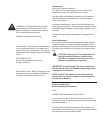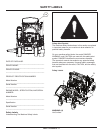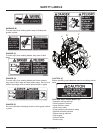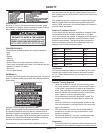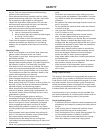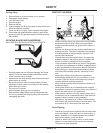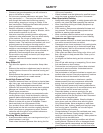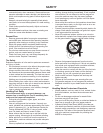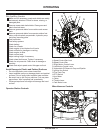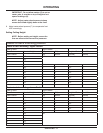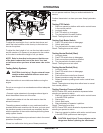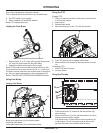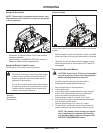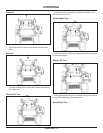
SAFETY
SAFETY - 8
ommended parts, when necessary. Grass catcher com-
ponents are subject to wear, damage, and deterioration
which could expose moving parts or allow objects to be
thrown.
Keep all nuts and bolts tight, especially blade attach-
ment bolts, to be sure the equipment is in safe working
condition.
Check brake operation frequently. Adjust and service
as required.
On multi-bladed machines, take care as rotating one
blade can cause other blades to rotate.
Prevent Fires
Remove grass and debris from engine compartment
and muffler area, before and after operating machine,
especially after mowing or mulching in dry conditions.
Empty the grass catcher completely before storing.
Always shut off fuel when storing or transporting ma-
chine, if the machine has a fuel shutoff.
Do not store machine near an open flame or source of
ignition, such as a water heater or furnace.
Check fuel lines, tank, cap, and fittings frequently for
cracks or leaks. Replace if necessary.
Tire Safety
Explosive separation of a tire and rim parts can cause seri-
ous injury or death:
Do not attempt to mount a tire without the proper equip-
ment and experience to perform the job.
Always maintain the correct tire pressure. Do not inflate
the tires above the recommended pressure. Never weld
or heat a wheel and tire assembly. The heat can cause
an increase in air pressure resulting in a tire explosion.
Welding can structurally weaken or deform the wheel.
When inflating tires, use a clip-on chuck and extension
hose long enough to allow you to stand to one side and
NOT in front of or over the tire assembly.
Check tires for low pressure, cuts, bubbles, damaged
rims or missing lug bolts and nuts.
Handling Fuel Safely
To avoid personal injury or property damage, use
extreme care in handling fuel. Fuel is extremely flam-
mable and fuel vapors are explosive:
Extinguish all cigarettes, cigars, pipes, and other
sources of ignition.
Use only an approved fuel container. Use only non-
metal, portable fuel containers approved by the Under-
writer’s Laboratory (U.L.) or the American Society for
Testing & Materials (ASTM). If using a funnel, make
sure it is plastic and has no screen or filter.
Never remove the fuel tank cap or add fuel with the
engine running. Allow engine to cool before refueling.
Never add fuel to or drain fuel from the machine in-
doors. Move machine outdoors and provide adequate
ventilation.
Clean up spilled fuel immediately. If fuel is spilled on
•
•
•
•
•
•
•
•
•
•
•
•
•
•
•
•
•
clothing, change clothing immediately. If fuel is spilled
near machine, do not attempt to start the engine but
move the machine away from the area of spillage.
Avoid creating any source of ignition until fuel vapors
have dissipated.
Never store the machine or fuel container where there
is an open flame, spark, or pilot light such as on a wa-
ter heater or other appliance.
Prevent fire and explosion caused by static electric dis-
charge. Static electric discharge can ignite fuel vapors
in an ungrounded fuel container.
Never fill containers inside a vehicle or on a truck or
trailer bed with a plastic liner. Always place containers
on the ground away from your vehicle before fueling.
Remove fuel-powered equipment from the truck or
trailer and refuel it on the ground. If this is not possible,
then refuel such equipment with a portable container,
rather than from a fuel dispenser nozzle.
Keep the nozzle in contact with the rim of the fuel tank
or container opening at all times until the fueling is
complete. Do not use a nozzle lock-open device.
Never overfill fuel tank. Replace fuel tank cap and
tighten securely.
Replace all fuel container caps securely after use.
For gasoline engines, do not use gas with methanol.
Methanol is harmful to your health and to the environ-
ment.
Handling Waste Product and Chemicals
Waste products, such as, used oil, fuel, coolant, brake
fluid, and batteries, can harm the environment and
people:
Do not use beverage containers for waste fluids -
someone may drink from them.
See your local Recycling Center or authorized dealer to
learn how to recycle or get rid of waste products.
A Material Safety Data Sheet (MSDS) provides spe-
cific details on chemical products: physical and health
hazards, safety procedures, and emergency response
techniques. The seller of the chemical products used
with your machine is responsible for providing the
MSDS for that product.
•
•
•
•
•
•
•
•
•
•
•
•




